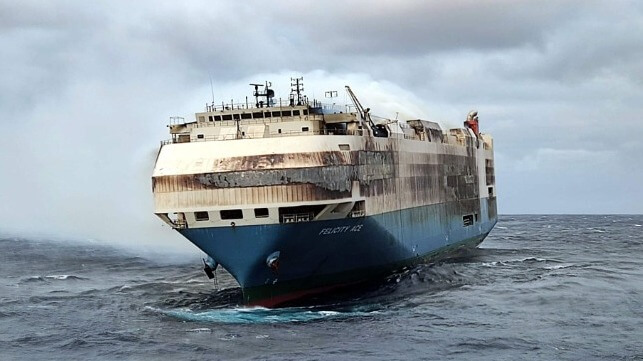Allianz: Shipping is Getting Safer, But Fires Remain a Concern

Shipping's long-term trend towards higher safety and fewer losses continued in 2021, according to marine insurer Allianz, but several high-profile incidents show that cargo fires are a "priority concern" for the industry - particularly for car carriers.
Over the course of the past year, two vessels were lost to fire in well-publicized incidents - the container feeder X-Press Pearl and the car carrier Felicity Ace. X-Press Pearl had a known problem with a cargo of nitric acid and had been attempting (without success) to gain access to a port of refuge to offload the affected container. Felicity Ace was carrying a large cargo of luxury cars made by Volkswagen brands, including Bentleys and Porsches, and she caught fire for unknown reasons. The total cost of her loss could exceed $400 million.
Fires are a leading cause of loss for car carriers. According to Allianz, the blaze is often sparked by short-circuits and other malfunctions in the vehicles stowed in these vessels' wide, open cargo holds. With few internal partitions, ro/ro decks allow the fire to spread horizontally with relative ease. Once the fire gets going, it can be difficult to extinguish - especially if there are electric cars on board.
The industry is beginning to recognize the unique fire hazards presented by the lithium-ion battery packs in electric cars. Li-ion batteries burn fiercely and are difficult to extinguish with conventional firefighting systems. Among other responses to the challenge, class society ABS has updated its rules for EVs on board ro/ro vessels, to include extra fire detection, alarms, and firefighting equipment. This new risk may also prompt a rethink of car carrier design: shipowner Höegh Autoliners says that it is taking electric vehicle fires into consideration in the layout of its next generation of ro/ros.
Cleanup cost
Felicity Ace went down in deep water, but many other casualties - like X-Press Pearl - sink or run aground where they can pollute coastal areas. For vessels that run into trouble near land, the rising cost of wreck removal and cleanup is a growing challenge for marine insurers. When something goes wrong, the degree of remediation that coastal states require is higher than it used to be, and in the worst cases (like the car carrier Golden Ray) the cost can easily reach the high nine digits.
"Environmental concerns are contributing to rising salvage and wreck removal costs as ship owners and insurers are expected to go the extra mile to protect the environment and local economies,” said Capt. Rahul Khanna, global head of marine risk consulting at Alliance Global Corporate and Specialty. “Previously, a wreck might have been left in-situ if it posed no danger to navigation. Now, authorities want wrecks removed and the marine environment restored, irrespective of cost.”
Allianz also raised concerns about the safety dynamics of the late-pandemic shipping surge. The demand for container shipping capacity has soared, and boxship operators have a strong financial incentive to find and sustain slots. At the margins, some small operators have drafted bulkers into the container trade, a task for which these vessels were not designed. In addition, boxship operators of all sizes have been keeping older container ships in service beyond their usual scrapping dates, with potential implications for safety and reliability.
"Although there are many well-managed and maintained fleets composed of older vessels, analysis has shown older container and cargo vessels (15 to 25 years old) are more likely to result in claims," noted Allianz. "The average age of a vessel involved in a total loss over the past 10 years is 28."
